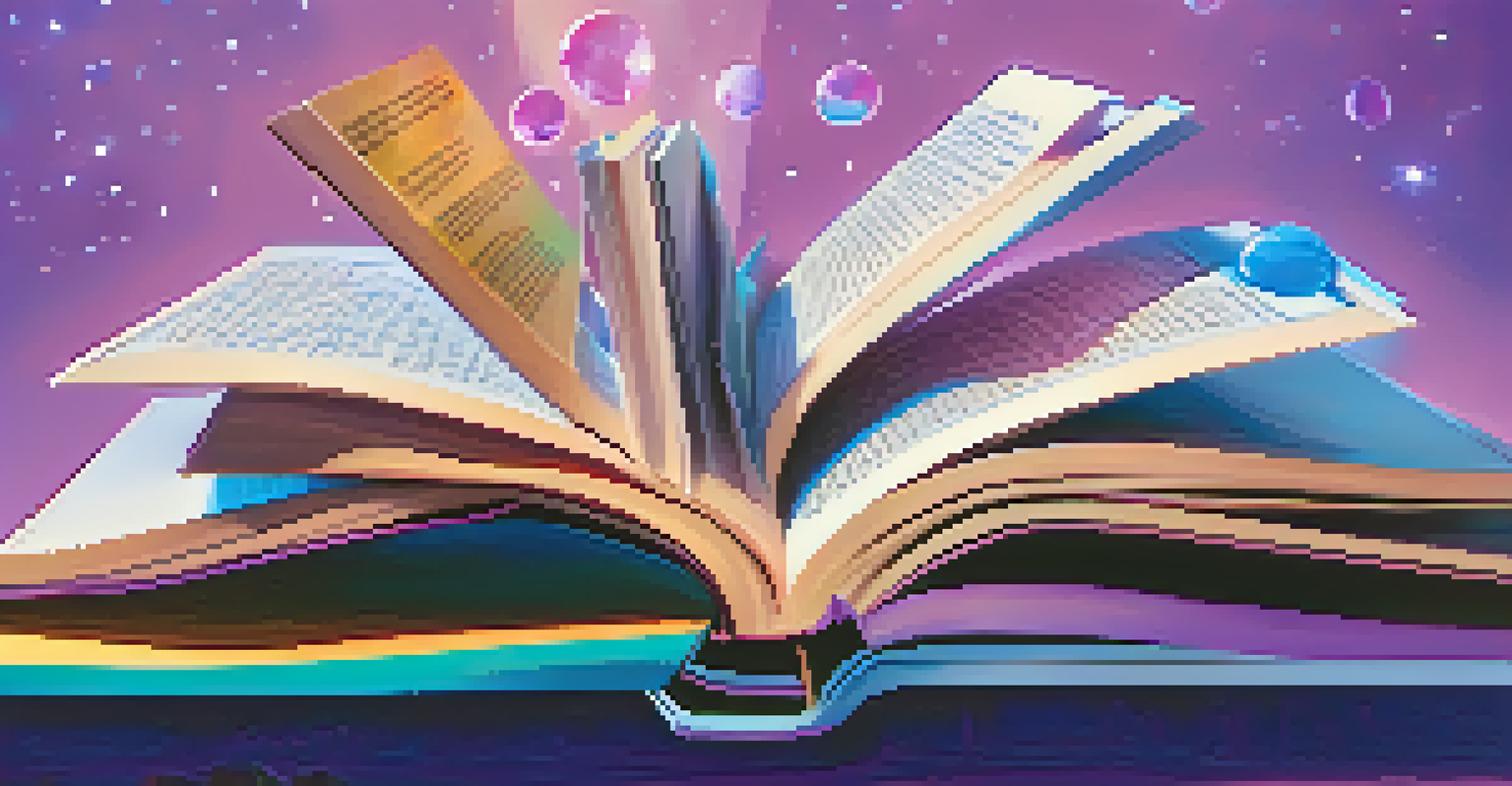Digital Signatures: How NFTs Authenticate Literary Works

Understanding Digital Signatures and Their Importance
Digital signatures are cryptographic techniques that validate the authenticity of digital messages or documents. Imagine them as a virtual fingerprint, unique to each creator, ensuring that their work hasn’t been tampered with. This technology plays a crucial role in securing digital transactions and communications, adding a layer of trust in our increasingly online world.
Digital signatures are the most effective way to ensure the integrity and authenticity of electronic documents.
In the realm of literature, where originality is paramount, digital signatures help authors protect their intellectual property. They provide a way to verify that a piece of writing is indeed the work of the claimed author, preventing plagiarism and unauthorized reproductions. This not only safeguards the creator's rights but also fosters confidence among readers and publishers alike.
Moreover, as the digital landscape evolves, the need for robust authentication methods becomes more pressing. Digital signatures are not just a trend; they represent a foundational shift in how we perceive ownership and authenticity in the digital age. By understanding their significance, we can appreciate the role they play in modern literary practices.
Introduction to NFTs and Their Role in Literature
Non-Fungible Tokens (NFTs) are unique digital assets that represent ownership of a specific item, often tied to digital or physical creations. Unlike cryptocurrencies, which are interchangeable, NFTs are distinct, making them ideal for representing literary works, art, and more. Think of NFTs as a digital certificate of authenticity, making it easy to prove who owns a particular piece of writing.

In the literary world, NFTs provide authors with new avenues for monetization and exposure. Writers can sell their works as NFTs, ensuring that they receive a fair share of the profits each time their piece is resold. This innovative approach not only empowers creators but also engages readers in a new way, turning them into stakeholders of the stories they love.
Digital Signatures Ensure Authenticity
Digital signatures act as a unique identifier for creators, validating the authenticity of digital works and protecting against tampering.
Additionally, NFTs can include metadata about the work, such as the creation date and ownership history. This added information enriches the narrative of the piece, offering readers a deeper connection to the work. As the market for digital literature grows, understanding NFTs becomes essential for both authors and readers.
How Digital Signatures Enhance NFT Authenticity
Digital signatures serve as the backbone of NFT authenticity, ensuring that each token is verifiably linked to its original creator. When an author mints an NFT, their digital signature is embedded within the token, certifying that the work is genuine. This level of security is crucial in an era where digital art and literature can easily be copied or altered.
NFTs enable authors to reclaim ownership of their work in a digital age that often overlooks intellectual property rights.
By using digital signatures, authors can confidently sell their literary works as NFTs, knowing that their identity is protected. This trust factor encourages more artists to enter the NFT space, leading to a diverse range of literary creations available for readers. The combination of NFTs and digital signatures creates a robust ecosystem for authors and fans alike.
Moreover, this authentication process extends beyond initial sales. As NFTs are bought and sold in the marketplace, the digital signatures ensure that each transaction is legitimate, maintaining the integrity of the literary work's lineage. This creates a transparent system where readers can trace the history of their favorite pieces, fostering a deeper appreciation for the authors.
Legal Implications of Digital Signatures and NFTs
The intersection of digital signatures, NFTs, and literature raises important legal questions about ownership and copyright. While digital signatures can verify authorship, the legal frameworks surrounding NFTs are still evolving. Understanding these implications is critical for authors who wish to protect their rights in this brave new digital world.
Copyright law traditionally applies to physical works, but with the rise of digital literature, the landscape is changing. Authors must navigate the complexities of copyright as they engage with NFTs, ensuring their rights are upheld in this new medium. This means being informed about how digital signatures and NFTs interact with existing laws.
NFTs Empower Authors and Readers
Non-Fungible Tokens provide authors with new monetization opportunities while engaging readers as stakeholders in the literary works they love.
In many cases, authors might need legal advice to fully understand their rights when creating and selling NFTs. By staying informed, writers can make empowered decisions about their work, ensuring they maintain control over their intellectual property. As the legal landscape develops, those who adapt will thrive in this innovative literary environment.
Challenges Writers Face with Digital Signatures and NFTs
While the benefits of digital signatures and NFTs are clear, writers also encounter challenges in adopting this technology. One significant hurdle is the technical knowledge required to effectively use these tools. Many authors may not be familiar with blockchain technology or how to mint an NFT, which can create barriers to entry.
Additionally, the market for NFTs can be volatile, with prices fluctuating dramatically. This unpredictability can deter some writers from fully embracing NFTs as a viable income source. It’s essential for authors to weigh the risks and rewards before diving into this digital realm.
Moreover, not all readers understand NFTs or their value, which can complicate marketing efforts. Authors must find ways to educate their audience about the benefits of owning literary NFTs, bridging the gap between technology and traditional readership. By overcoming these challenges, writers can harness the power of digital signatures and NFTs to enhance their careers.
Real-World Examples of Literary NFTs in Action
Several authors have successfully embraced NFTs, showcasing the potential of this innovative approach. For instance, renowned writers have auctioned their works as NFTs, allowing fans to own unique digital copies. This not only generates revenue for the authors but also creates a new category of collectibles for readers.
Additionally, platforms have emerged that specifically cater to literary NFTs, providing authors with the tools and resources needed to mint and sell their work. These platforms often incorporate digital signatures to enhance authenticity, giving authors peace of mind. As this trend grows, more writers are likely to explore the possibilities of combining literature with blockchain technology.
Legal Challenges in Digital Literature
The evolving legal landscape surrounding digital signatures and NFTs necessitates that authors understand their rights to protect their intellectual property.
Moreover, literary NFTs have sparked conversations about the future of publishing, prompting discussions on how traditional publishing models may need to adapt. By examining these real-world examples, writers can glean insights into how to navigate their own journeys in the NFT space, ensuring they stay ahead in the evolving literary landscape.
The Future of Digital Signatures and NFTs in Literature
As technology continues to evolve, the future of digital signatures and NFTs in literature looks promising. We can anticipate more sophisticated tools that simplify the process for authors, making it easier to authenticate and sell their works. This potential for innovation could open doors for emerging writers who may have previously felt sidelined in the publishing industry.
Furthermore, as readers become more familiar with NFTs, the demand for literary tokens is likely to rise. This shift could lead to new business models for authors, transforming how literary works are marketed and consumed. The integration of digital signatures within this framework will remain essential for maintaining trust and authenticity.

Ultimately, the intersection of technology and literature presents exciting opportunities for both writers and readers. By embracing these advancements, the literary community can foster a more inclusive and dynamic environment, where creators are celebrated, and their contributions are securely recognized. The journey ahead is sure to be fascinating as we navigate this new era together.